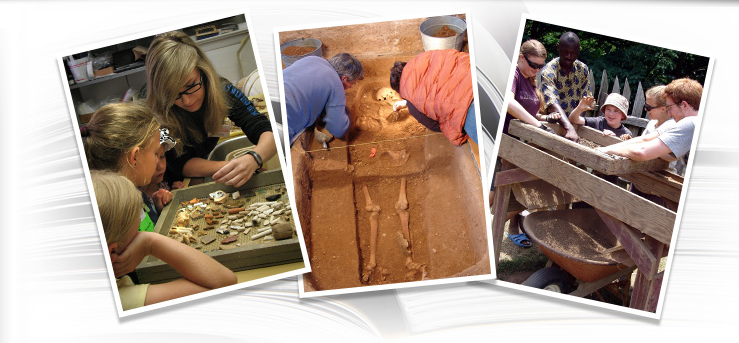2013 Week 3
We are hoping desperately that it will stop raining. Every time it rains, we need to stop digging. The dirt gets too wet to put through the screen, artifacts get missed and we run the risk of destroying the features we look for. When it rains in the evening, after work hours, it takes us an hour just to get the water out of the plastic square covers and, if there was a hole in the plastic, that unit can not be worked that day. This week we lost two whole days to rain and a portion of the others to cleaning up after rain. As there is a limited time to accomplish our research, every day lost makes it so much harder.
Despite the rain, the students are making progress.

Unbackfilling units above the covered cellar.
In the area around the house, we are still unbackfilling the selected units mentioned in Week 1. The photo shows the area with the covered cellar being cleared. It will be awhile before we can clean this up, redefine the features and begin excavating. In the house itself, we are almost finished with the units of the possible cellar. This coming week, we will begin working on the remaining unexcavated units and possibly get the feature exposed.
Excavation continues on the north edge of the site. We continue to find a lot of prehistoric material both stone and pottery as well as some 17th-century material. As we are close to the former location of the Brome-Howard house, we find many things related to that occupation.
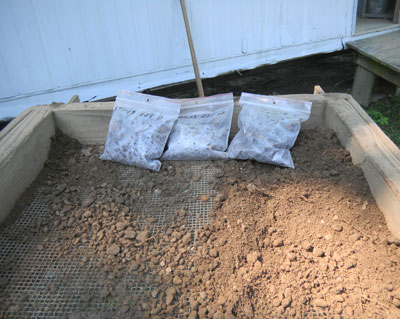
Bags full of coal in the screen.
One of the things we find in abundance is coal. The photo shows three very full bags filled with coal from one unit and there was even more found by the end of the week. I often get asked why we save it all. It may not be a very exciting part of the archaeology but it is important nonetheless. Studying the distribution of coal in the plow zone will aid in understanding how the site was used in the 19th century. This not only informs us about the site use during that period but also about impacts to the 17th-century features as well.
Also related to the 19th- or 20th- century use of the site is a large oyster shell feature found this week.
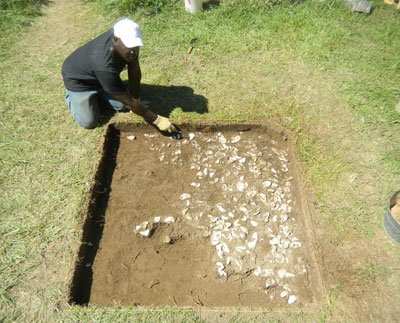
Oyster shell feature in plow zone.
The shell was found just below topsoil and resting on or in plow zone. The stratigraphic position of the oyster shell would suggest the date but we also recovered from among the shell some machine cut nails. These nails were made primarily in the 19th century. The shell feature will be mapped this coming week and then excavated. I will probably have more to say about next week.
This week, we found two more projectile points.
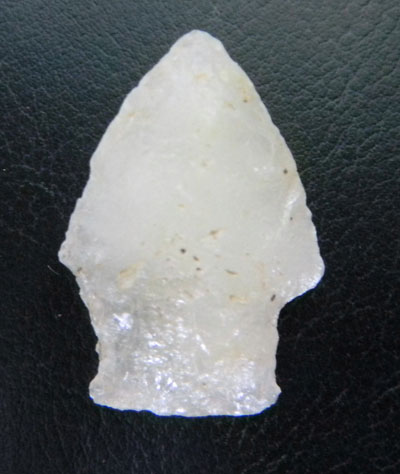
Calvert point from the Early Woodland period.
The photo shows one of these, a short point, made of quartz, of a type identified as a Calvert point. Generally, archaeologists date this type of point to the Early Woodland period, c. 750 BC to 200 AD, and it fits well with the other prehistoric artifacts we have been finding.
At the Calvert house site, we always find a large number of pieces of 17th-century table glass. It seems that, over the life of the building, its occupants imported many different vessels.
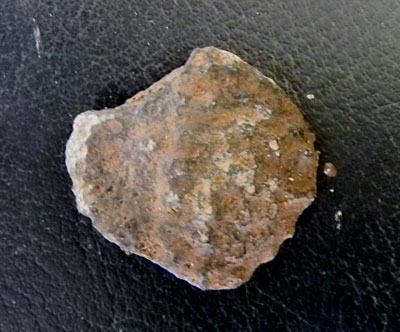
Glass prunt used on 17th-century table glass.
One of the most common items, which we seem to find each year, are the raspberry punts used frequently on German glassware. They are frequently shown in 17th-century Dutch paintings on vessels known as roemers. They were decorative but also functional. As people often had greasy fingers while eating, the prunts kept the glass from slipping. The concept is still used today on molded plastic bottles.


